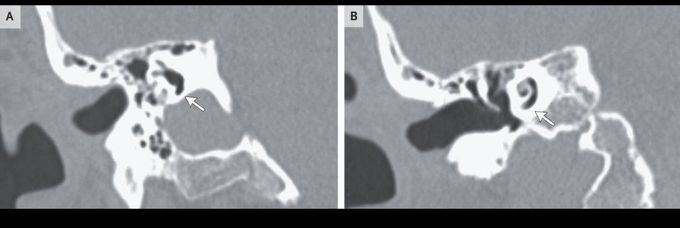


Pneumolabyrinth and Pneumocochlea
A 46-year-old man presented to the emergency department with tinnitus and dizziness after falling backward off a truck from a height of approximately 2 m. On physical examination, right occipital ecchymosis and left-beating nystagmus were observed. The results of Rinne and Weber tests indicated sensorineural hearing loss in the right ear. No otorrhagia, hemotympanum, cerebrospinal fluid leakage, or cranial nerve abnormalities were noted. Computed tomographic imaging of the head revealed an occipital bone fracture and a right temporal bone fracture through the otic capsule — the dense bone surrounding the inner ear structures — which resulted in abnormal findings of air in the labyrinth (also known as pneumolabyrinth; Panel A, arrow) and cochlea (also known as pneumocochlea; Panel B, arrow). There was minor subarachnoid hemorrhage. Temporal bone fractures that disrupt the otic capsule require urgent otolaryngologic evaluation. Such fractures are associated with a higher risk of sensorineural hearing loss, facial nerve paralysis, and cerebrospinal fluid leak than temporal bone fractures that do not disrupt the otic capsule. The patient was treated medically with a glucocorticoid on a tapering schedule. At the 6-month follow-up, surgical intervention was offered, given the patient’s persistent sensorineural hearing loss, but he declined.

